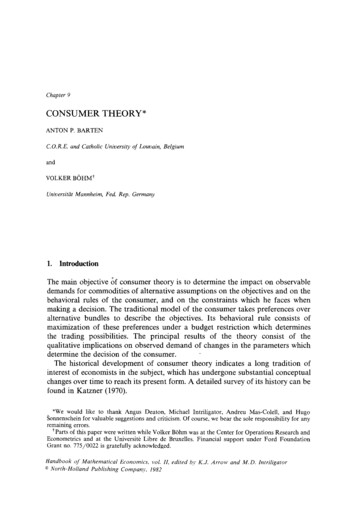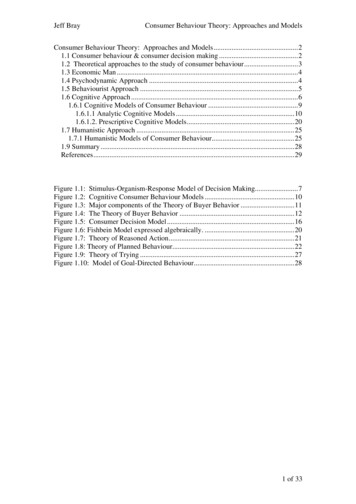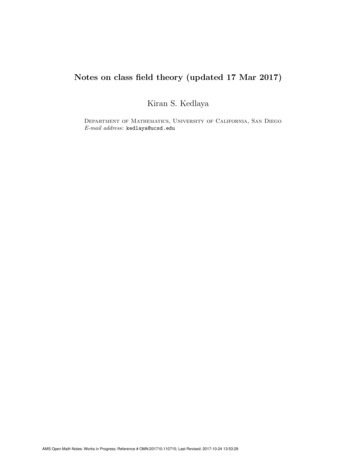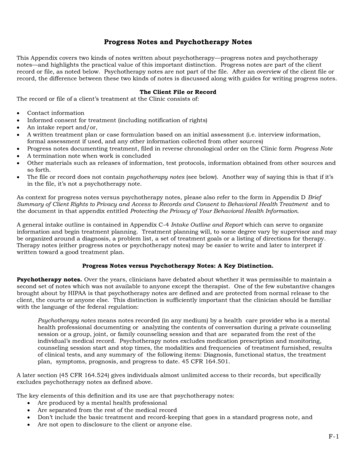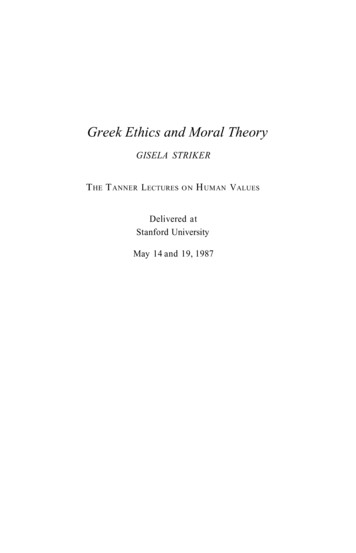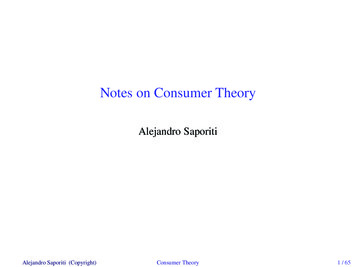
Transcription
Notes on Consumer TheoryAlejandro SaporitiAlejandro Saporiti (Copyright)Consumer Theory1 / 65
Consumer theoryReference: Jehle and Reny, Advanced Microeconomic Theory, 3rd ed.,Pearson 2011: Ch. 1.The economic model of consumer choice has 4 ingredients:1. The consumption set;2. The preference relation;3. The feasible (budget) set;4. Behavioral assumptions (e.g., rationality).This basic structure gives rise to a general theory of choice which is used inseveral social sciences (e.g., economics & political science).For concreteness, we focus on explaining the behavior (choices) of arepresentative consumer, a central actor in much of economic theory.Alejandro Saporiti (Copyright)Consumer Theory2 / 65
Consumption setThe consumption or choice set represents the set of all alternatives availableto the (unrestricted) consumer.In economics, these alternatives are called consumption plans.A consumption plan represents a bundle of goods, and is written as a vector xconsisting of n different consumption goods, x (x1 , . . . , xn ).Typical assumptions on X are:1. 6 X Rn (i.e., nonempty & each good measured in infinitelydivisible and nonnegative units);2. X is closed;3. X is convex;4. 0 X.Alejandro Saporiti (Copyright)Consumer Theory3 / 65
Consumer preferencesConsumer’s preferences represent his attitudes toward the objects of choice.The consumer is born with these attitudes, i.e. preferences are a ‘primitive’ inclassical consumer theory.To represent them formally, we use the at least as good as binary relation % onX; and for any two bundles x1 and x2 , we say that,1. The consumer is indifferent between x1 and x2 , denoted by x1 x2 , ifand only if (iff) x1 % x2 and x2 % x1 ;2. The consumer strictly prefers x1 over x2 , indicated by x1 x2 , iffx1 % x2 and [x2 % x1 ].Alejandro Saporiti (Copyright)Consumer Theory4 / 65
Consumer preferencesWe require % to satisfy the following axioms:1. Completeness: For all x1 and x2 in X, either x1 % x2 or x2 % x1 ;2. Transitivity: For any three bundles x1 , x2 and x3 in X, if x1 % x2 andx2 % x3 , then x1 % x3 .When % satisfies these axioms it is said to be a rational preference relation.Under completeness and transitivity, for any two bundles x1 , x2 X, exactlyone of the following three possibilities holds: either x1 x2 ,x2 x1 , orx1 x2 .Thus, the rational preference relation % offers a weak or partial order of X(complete and transitive), ranking any finite number of alternatives in X frombest to worst, possibly with some ties.Alejandro Saporiti (Copyright)Consumer Theory5 / 65
Consumer preferencesApart from Axioms 1 & 2, we demand three additional properties on %:3. Continuity: For all x0 X, the sets {x X : x % x0 } and{x X : x0 % x} are closed in X Rn ; Continuity rules out openareas in the indifference set;that is, the set{x X : x x0 } {x X :x % x0 } {x X : x0 % x} isclosed. It rules out ‘suddenpreference reversals’ such asthe one happening in Fig 1,where (b, 0) ℓ (x, 1) for allx b, but (b, 1) ℓ (b, 0).Alejandro Saporiti (Copyright)Figure 1: Lexicographic preferences %ℓon R2 ; (a1 , a2 ) %ℓ (b1 , b2 ) iff eithera1 b1 , or a1 b1 and a2 b2 .Consumer Theory6 / 65
Consumer preferences4. Strict monotonicity: For all x1 , x2 X, (a) if x1 contains at least as muchof every commodity as x2 , then x1 % x2 ; (b) if x1 contains strictly moreof every commodity, then x1 x2 . This axiom rules out thepossibility of having‘indifference zones’; it alsoeliminates indifference setsthat bend upward and containpositively sloped segments. Strict monotonicity impliesthat the better (resp. worse)than set is above (resp.below) the indifference set.Alejandro Saporiti (Copyright)Figure 2: Violation of strict monotonicity.Consumer Theory7 / 65
Consumer preferences5. Strict convexity: For all x1 , x2 X, if x1 6 x2 and x1 % x2 , then for allα (0, 1), αx1 (1 α)x2 x2 . It rules out concave to the origin segments in the indifference sets.It prevents the consumer from preferring extremes in consumption.x2x2x1x1α x1 (1 α) x2α x1 (1 α) x2x2x2x1x1Figure 3: ConvexAlejandro Saporiti (Copyright)Figure 4: NonconvexConsumer Theory8 / 65
Consumer preferencesAxioms 3-5 exploit the structure of the space X: Continuity uses the ability to talk about closeness. Monotonicity uses the orderings on the axis (the ability to comparebundles by the amount of any particular commodity). It gives commodities the meaning of ‘goods’: More is better. Convexity uses the algebraic structure (the ability to speak of the sum oftwo bundles and the multiplication of a bundle by a scalar). That is, it assumes the existence a “geography” of the set of alternatives,so that we can talk about one alternative being between two others. It’s appropriate when the argument “if a move is an improvement so isany move part of the way” is legitimate, while the argument “if a move isharmful then so is a move part of the way” is not.Alejandro Saporiti (Copyright)Consumer Theory9 / 65
Utility representationWhen preferences are defined over large sets of alternatives, it is usuallyconvenient to employ calculus methods to work out the best options.To do that, we’d like to represent the information conveyed by the preferencerelation % through a function.A real-valued function u : Rn R is said to be a utility representation of thepreference relation % if for all x1 , x2 X Rn x1 % x2 u(x1 ) u(x2 ).(1)Theorem 1 (Debreu, 1954)If the preference relation % is complete, transitive and continuous, then itpossesses a continuous utility representation u : Rn R.Consistent pair-wise comparability over X and some topological regularity areenough for a numerical representation of %.Alejandro Saporiti (Copyright)Consumer Theory10 / 65
Invariance of the utility functionThe ordinal nature of the utility representation embedded in (1) implies that autility function u : Rn R is unique up to any strictly increasingtransformation.More formally, suppose u : Rn R represents the preference relation %.Then, for any strictly increasing transformation f : R R, the functionv(x) f (u(x)) x X,(2)also represents %.To see this, recall that u(·) represents % if for all x, y X,Alejandro Saporiti (Copyright)x y u(x) u(y),(3)x y u(x) u(y).(4)Consumer Theory11 / 65
Invariance of the utility functionMoreover, note that for any two real numbers a, b R,(i) f (a) f (b) if and only if a b; and(ii) f (a) f (b) if and only if a b.Thus, using the definition of v given in (2) and (i)-(ii), for all x, y Xv(x) v(y) f (u(x)) f (u(y)) u(x) u(y),(5)v(x) v(y) f (u(x)) f (u(y)) u(x) u(y).(6)Combining (5) with (3), we havev(x) v(y) x y.Similarly, combining (6) with (4), we havev(x) v(y) x y.Hence, v(·) represents %.Alejandro Saporiti (Copyright)Consumer Theory12 / 65
QuasiconcavityA function u(·) is quasiconcave on a convex set X Rn if and only if for allx, y X, and for all λ (0, 1),u(λ x (1 λ) y) min{u(x), u(y)}.( )Strict quasiconcavity is defined analogously by replacing the weak inequalityin ( ) with the strict inequality.A function g(·) is quasiconvex on a convex set X Rn if and only if for allx, y X, and for all λ (0, 1),g(λ x (1 λ) y) max{g(x), g(y)}.Alejandro Saporiti (Copyright)Consumer Theory13 / 65
QuasiconcavityAlternatively, we could say that a function u(·) is quasiconcave on a convexset X Rn if for all c R the upper contour set {x X : u(x) c} is convex.Alejandro Saporiti (Copyright)Consumer Theory14 / 65
Quasiconcavityu(x)u(x)u(x)yyu(x)xFigure 5: QuasiconcaveyyxFigure 6: Not quasiconcaveIn the the picture above, every horizontal cut through the function must beconvex for the function to be quasi-concave. Thus, u(·) is quasiconcave inFig. 5, whereas it isn’t in Fig. 6.Alejandro Saporiti (Copyright)Consumer Theory15 / 65
QuasiconcavityAn important property of quasiconcavity is that it’s preserved underincreasing transformations.Proposition 1If u : X Rn R is quasiconcave on X and φ : R R is a monotoneincreasing transformation, then φ(u(·)) is quasiconcave.The proof of Proposition 1 is as follows. We wish to show that for all x, y X,and for all λ (0, 1),φ(u(λ x (1 λ) y)) min{φ(u(x)), φ(u(y))}.Alejandro Saporiti (Copyright)Consumer Theory16 / 65
QuasiconcavitySince u is quasiconcave, for all x, y X, and for all λ (0, 1),u(λ x (1 λ) y) min{u(x), u(y)}.(7)Applying φ to both sides of (7),φ(u(λ x (1 λ) y)) φ(min{u(x), u(y)}).(8)φ(min{u(x), u(y)}) min{φ(u(x)), φ(u(y))}.(9)But,Hence, combining (8) with (9), we get the desired result; that is, for allx, y X, and for all λ (0, 1),φ(u(λ x (1 λ) y)) min{φ(u(x)), φ(u(y))}.Alejandro Saporiti (Copyright)Consumer Theory17 / 65
Indifference curve & marginal utilityGiven a utility function u(·), the indifference curve (level contour set) thatpasses through the bundle x̄ X is defined as{x X : u(x) u(x̄)}.If u(·) is quasiconcave, then the indifference curves are convex (recall Fig. 5:the upper contour sets of a quasi-concave function are convex).If u is differentiable, then for alli 1, . . . , n, the marginal utility of xiat x (x1 , . . . , xn ) isMUi (x) x2 u(x). xi x2At x̄, consumer is willing tosubstitute x1 against x2 at the rate of x1 / x2 .Alejandro Saporiti (Copyright)%Consumer Theoryx̄ x11 x x2u(x̄)x118 / 65
Marginal rate of substitutionIf we’d like to vary xi by a small amount dxi , while keeping utility u(x̄)constant, how much do we need to change xj 6 xi ?Formally, the total differential of ū u(x̄) is0 u(x̄) u(x̄)dx1 . . . dxn . x1 xnSince we only care about changes in xj caused by changes in xi , we setdxh 0 for all h 1, . . . , n, with h 6 i, j.Thus, the total differential simplifies to u(x̄) u(x̄)dxi dxj 0. xi xjAlejandro Saporiti (Copyright)Consumer Theory19 / 65
Marginal rate of substitutionRearranging the terms, we get that the marginal rate of substitution (MRS)between good i and good j is given byMRSij (x̄) dxjdxidu 0 u(x̄)/ xiMUi(x̄) . u(x̄)/ xjMUj(x̄)MRSij (x̄) is the rate at which good j can be exchanged per unit of good iwithout changing consumer’s utility. The absolute value of the MRSis equal to the ratio of marginalutilities of i and j at x̄;The MRS equals the slope of theindifference curve.When preferences are convex,the MRS between two goods isdecreasing.Alejandro Saporiti (Copyright)x2 M RS12 (x01 , x02 ) M RS12 (x11 , x12 ) x02x12Consumer Theoryū u(x1 , x2 )x01x11x120 / 65
Budget setObviously, the consumer must be able to afford his consumption bundle. Thisgenerally restricts his choice set. We assume Each good has a strictly positive price pi 0, for all i 1, . . . , n; The consumer is endowed with income y 0.Thus consumer’s purchases are restricted by the budget constraintnXpi xi y.i 1The budget set is the set of bundles that satisfy this constraint:B(p, y) {x X : p1 x1 . . . pn xn y}.Alejandro Saporiti (Copyright)Consumer Theory21 / 65
Budget set (2-goods)x2x̂2 %yp2FBudget set B(p, y):x2 py2 pp12 x1 .p pp12pBudget frontier F:x2 py2 pp12 x1with slope p1 /p2 .B(p, y) {x X : p1 x1 p2 x2 y}p2x1p1Alejandro Saporiti (Copyright)x̂1 Consumer Theoryyp122 / 65
Behavioral assumption: RationalitySo far, we have a model capable of representing consumer’s feasible choicesand his preferences over them.Now we restrict consumer’s behavior assuming that he is a rational agent, inthe sense that he chooses the best alternative in the budget set B(p, y)according with his preference relation %.Thus rationality in microeconomics has two different meanings:1. Consumer orders consistently (transitively) all possible alternatives;2. Consumer chooses the best alternative among those in the feasible set.We are now ready to study consumer’s optimal choices!Alejandro Saporiti (Copyright)Consumer Theory23 / 65
Utility maximizationFormally, consumer’s utility maximization problem (UMP) ismax u(x1 , . . . , xn )x XPns.t.i 1 pi xi y.(10)The utility function u is a real valued and continuous function.The budget set B is a nonempty (0 X), closed, bounded (pi 0 i) and thusa compact subset of Rn .Therefore, by the Weierstrass theorem, a maximum of u over B exists.Let’s assume the solution of (10), denoted x , is interior, i.e. i, x i 0; thenUMP can be solved using the Kuhn-Tucker method.Set up the Lagrange function"L(x1 , . . . , xn , λ) u(x1 , . . . , xn ) λ y Alejandro Saporiti (Copyright)Consumer TheorynXi 1#pi xi .(11)24 / 65
Interior solution (x i 0)Differentiating L(·) w.r.t. each argument, we get the Kuhn-Tucker first orderconditions (FOC’s) at the critical bundle x : L(x , λ ) u(x ) λ pi 0, i 1, . . . , n, xi xi(12)nX L(x , λ ) y pi x i 0, λi 1!nX λ 0, and λ · y pi xi 0.(13)(14)i 1Imposing strict monotonicity, (13) must be satisfied with equality, andtherefore (14) becomes redundant.Alejandro Saporiti (Copyright)Consumer Theory25 / 65
Interior solution (x i 0)Assuming MUi (x ) 0 for some i, it becomes clear from (12) that u(x ) 1 u(x ) 1 u(x ) 1 ··· λ 0. x1 p1 x2 p2 xn pnHence, the (absolute value of the) marginal rate of substitution at x betweenany two goods equals the price ratio of those goods: MRSij (x ) MUi (x )pi . MUj (x )pj(15)Otherwise, the consumer can improve by substituting a good with a lower MUby a good with a higher MU.The Lagrange multiplier λ is called the shadow price of money, and it givesthe utility of consuming one extra currency unit.Alejandro Saporiti (Copyright)Consumer Theory26 / 65
Interior solution (2 goods)Graphically, in the case of two goods (15) is equivalent to the tangencybetween the highest indifference curve and the budget constraint.x2FOC: u(x ) λ · g(x )g(x ) y p1 x 1 p2 x 2 0 u(x ) (M U1 (x ), M U2 (x ))x g(x ) ( p1 , p2 )u x1Figure 7: In
Consumer’s preferences represent his attitudes toward the objects of choice. The consumer is born with these attitudes, i.e. preferences are a ‘primitive’ in classical consumer theory. To represent them formally, we use the at least as good as binary relation %on X;
